Entry Database : PDB / ID : 4ibmTitle Crystal structure of insulin receptor kinase domain in complex with an inhibitor Irfin-1 Insulin receptor Keywords / / / / / / Function / homology Function Domain/homology Component
/ / / / / / / / / / / / / / / / / / / / / / / / / / / / / / / / / / / / / / / / / / / / / / / / / / / / / / / / / / / / / / / / / / / / / / / / / / / / / / / / / / / / / / / / / / / / / / / / / / / / / / / / / / / / / / / / / / / / / / / / / / / / / / / / / / / / Biological species Homo sapiens (human)Method / / / Resolution : 1.8 Å Authors Wu, J. / Anastassiadis, T. / Duong-Ly, K.C. / Peterson, J.R. Journal : J.Biol.Chem. / Year : 2013Title : A highly selective dual insulin receptor (IR)/insulin-like growth factor 1 receptor (IGF-1R) inhibitor derived from an extracellular signal-regulated kinase (ERK) inhibitor.Authors : Anastassiadis, T. / Duong-Ly, K.C. / Deacon, S.W. / Lafontant, A. / Ma, H. / Devarajan, K. / Dunbrack, R.L. / Wu, J. / Peterson, J.R. History Deposition Dec 8, 2012 Deposition site / Processing site Revision 1.0 Aug 21, 2013 Provider / Type Revision 1.1 Aug 28, 2013 Group Revision 1.2 Nov 20, 2013 Group Revision 1.3 Nov 15, 2017 Group / Category / Item Revision 1.4 Feb 28, 2024 Group / Database references / Derived calculationsCategory chem_comp_atom / chem_comp_bond ... chem_comp_atom / chem_comp_bond / database_2 / struct_ref_seq_dif / struct_site Item _database_2.pdbx_DOI / _database_2.pdbx_database_accession ... _database_2.pdbx_DOI / _database_2.pdbx_database_accession / _struct_ref_seq_dif.details / _struct_site.pdbx_auth_asym_id / _struct_site.pdbx_auth_comp_id / _struct_site.pdbx_auth_seq_id
Show all Show less
 Yorodumi
Yorodumi Open data
Open data Basic information
Basic information Components
Components Keywords
Keywords Function and homology information
Function and homology information Homo sapiens (human)
Homo sapiens (human) X-RAY DIFFRACTION /
X-RAY DIFFRACTION /  SYNCHROTRON /
SYNCHROTRON /  MOLECULAR REPLACEMENT / Resolution: 1.8 Å
MOLECULAR REPLACEMENT / Resolution: 1.8 Å  Authors
Authors Citation
Citation Journal: J.Biol.Chem. / Year: 2013
Journal: J.Biol.Chem. / Year: 2013 Structure visualization
Structure visualization Molmil
Molmil Jmol/JSmol
Jmol/JSmol Downloads & links
Downloads & links Download
Download 4ibm.cif.gz
4ibm.cif.gz PDBx/mmCIF format
PDBx/mmCIF format pdb4ibm.ent.gz
pdb4ibm.ent.gz PDB format
PDB format 4ibm.json.gz
4ibm.json.gz PDBx/mmJSON format
PDBx/mmJSON format Other downloads
Other downloads 4ibm_validation.pdf.gz
4ibm_validation.pdf.gz wwPDB validaton report
wwPDB validaton report 4ibm_full_validation.pdf.gz
4ibm_full_validation.pdf.gz 4ibm_validation.xml.gz
4ibm_validation.xml.gz 4ibm_validation.cif.gz
4ibm_validation.cif.gz https://data.pdbj.org/pub/pdb/validation_reports/ib/4ibm
https://data.pdbj.org/pub/pdb/validation_reports/ib/4ibm ftp://data.pdbj.org/pub/pdb/validation_reports/ib/4ibm
ftp://data.pdbj.org/pub/pdb/validation_reports/ib/4ibm Links
Links Assembly
Assembly
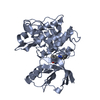
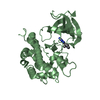
 Components
Components Homo sapiens (human) / Gene: INSR / Production host:
Homo sapiens (human) / Gene: INSR / Production host: 
 X-RAY DIFFRACTION / Number of used crystals: 1
X-RAY DIFFRACTION / Number of used crystals: 1  Sample preparation
Sample preparation SYNCHROTRON / Site:
SYNCHROTRON / Site:  NSLS
NSLS  / Beamline: X4C / Wavelength: 1 Å
/ Beamline: X4C / Wavelength: 1 Å Processing
Processing MOLECULAR REPLACEMENT / Resolution: 1.8→50 Å / Cor.coef. Fo:Fc: 0.955 / Cor.coef. Fo:Fc free: 0.938 / SU B: 5.295 / SU ML: 0.076 / Cross valid method: THROUGHOUT / ESU R: 0.128 / ESU R Free: 0.122 / Stereochemistry target values: MAXIMUM LIKELIHOOD / Details: HYDROGENS HAVE BEEN ADDED IN THE RIDING POSITIONS
MOLECULAR REPLACEMENT / Resolution: 1.8→50 Å / Cor.coef. Fo:Fc: 0.955 / Cor.coef. Fo:Fc free: 0.938 / SU B: 5.295 / SU ML: 0.076 / Cross valid method: THROUGHOUT / ESU R: 0.128 / ESU R Free: 0.122 / Stereochemistry target values: MAXIMUM LIKELIHOOD / Details: HYDROGENS HAVE BEEN ADDED IN THE RIDING POSITIONS Movie
Movie Controller
Controller






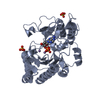
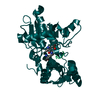
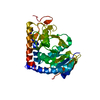

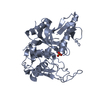

 PDBj
PDBj














